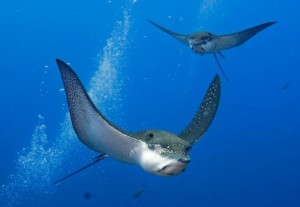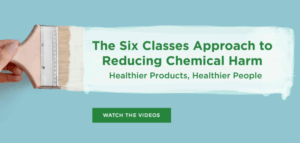August 2017: It doesn't have to be that way
In this edition:
- Some promising PFAS policy news from Washington DC
- Associations between flame retardant applications in furniture foam
- Can foam plastic building insulation be used safely without flame retardants?
- Are there toxic chemicals coating your pet food bag?

I am just back from a snorkeling, bird watching and volcano hiking holiday in Nicaragua. My memories of marshes teeming with herons and egrets and of a giant Eagle Ray powering through the water above brightly-colored coral reefs renews my passion to reduce the unnecessary and harmful chemicals in these magnificent creatures and in all of us. And so very sadly the highest levels of persistent toxics like flame retardants and fluorinated chemicals are found in large marine creatures and human infants. But it doesn’t have to be that way.
One step towards a better understanding of toxic substances is the recent release of our new videos on the Six Classes of chemicals of concern. If you haven’t already, please check out our four minute long videos by clicking the image below, and then please forward the link. The videos were featured on the home page of the UC Berkeley College of Chemistry. Bev Thorpe, an NGO colleague, wrote: “These videos are really well done and informative and… a GREAT resource for NGOs, companies, schools, procurement reps, government… four minutes of everything you need to know about six classes of the most hazardous chemicals found in common household products.”

Our new Six Classes website was also referenced in the New York Times opinion piece How to Save Your Sperm relating chemical exposures to a recent 50% decrease in men’s sperm counts. Author Evan Helper-Smith wrote of “a more categorical approachto safer chemicals, drawing attention to entire classes of chemicals that might be better avoided.”
See below for some good news about toxics from Washington DC to which Tom and I likely contributed. Please also check out Emily Monossons new blog on Dr. Herb Needleman an environmental hero who brilliantly first demonstrated the harm of low levels of lead exposure upon children’s brain development.
Avery, Tom and I are now heading to Vancouver BC to share our current work and lead our annual Science and Policy workshop before for the 37th International Symposium on Halogenated Persistent Organic Pollutants (DIOXIN 2017). At the same time members of the GSP team will be camping next week to get a great view of the eclipse. We hope many of you will get to see this spectacular natural phenomenon.
When we return we will get ready for our September 7 party celebrating the Six Classes at the Sweetwater Music Hall and also the Solano Stroll on September 10. You are invited to join us for both and if you would like to participate in our study of highly fluorinated chemicals in pet food bags, please bring us samples as described below.
We hope you enjoy the rest of your summer.
Kind regards,
Arlene and the GSP team
Some promising PFAS policy news from Washington DC

In June, Science and Policy Fellow Tom Bruton and I traveled to DC to speak with policy-makers about science-based ideas to protect our nation’s drinking water and health from the impact of highly fluorinated chemicals (PFASs). We met with about 40 Senate and House staff members from both sides of the aisle.
We were delighted to find some of our recommendations included in amendments to the Department of Defense (DOD) spending authorization bills passed by the House and Senate:
* Both require DOD to fund health studies of communities with PFAS contaminated drinking water from military use of firefighting foam.
* The class concept was in the Senate version on “the cumulative human health implications of multiple types of PFAS contamination.”
* The House version calls on DoD to report on its progress in moving towards foam without fluorinated chemicals.
Nothing is certain yet, but the inclusion of these amendments in the defense spending bill is encouraging.
There is good news out of Europe as well. Perfluorohexane sulfonate (PFHxS), a C6 compound similar to PFOS been added to the list of chemicals to be regulated under REACH. I was very surprised to learn that this C6 is even more bioaccumulative than PFOS.
Associations between flame retardant applications in furniture foam

Researchers at UCSF published a scientific review concluding that exposure to the flame retardant PentaBDE, primarily used in polyurethane foam in North America before its phase-out in 2005, is associated with lower child IQ.
In a separate study out of Duke University, researchers compared levels of flame retardants in furniture with levels in house dust and in people. They found that people who owned furniture containing that flame retardant PentaBDE had higher levels in their blood, adding further evidence that upholstered furniture is a major source of PentaBDE in humans. They also concluded that foam-containing furniture is a significant source of flame retardants in house dust.
The good news is that thanks to a recent update to California’s residential furniture flammability standard, PentaBDE and other flame retardants are no longer needed in home furniture and most children’s products. You can learn more about flame retardants in our new four-minute video.
Can foam plastic building insulation be used safely without flame retardants?

Our 2012 paper Flame retardants in building insulation: a case for re-evaluating building codes summarizes research showing the health harm and lack of fire safety benefit of adding flame retardant chemicals to such insulation. It has provided the scientific basis for code change proposals to allow the safe use of foam plastic building insulation without flame retardants.
The paper’s editor wrote us that this paper is free to download for a few months, based on the useful information it contains. Please share this free link with others to whom the paper would be of interest.
Building insulation is one of the largest uses of brominated flame retardants, and exposures to these flame retardants and their hazardous byproducts can happen during manufacturing, installation, use, demolition, and disposal. So changing codes to allow safe use of insulation without these chemicals is critical work.
We continue to persevere towards this important goal, though it is not easy. You can learn more here or contact [email protected] if you might like to join this important effort.
Are there toxic chemicals coating your pet food bag?

Our Institute and colleagues reported finding fluorinated chemicals in about a third of take-out food packaging samples tested. Previous research found these chemicals can migrate from packaging into the food.
Now, we are launching a similar study to learn if our pets might also be exposed to fluorinated chemicals from their food packaging. Please join our study by sending us a sample of the packaging around your pets food or treats and we will test it for fluorinated chemicals.
Directions: Cut out a 5×5 inch sample if possible of the food or treat bag and place it in a ziplock bag. Record the product information (item name, brand, store name and location) and your contact information (name, email, and mailing address) on a piece of paper. Put the paper in the ziplock bag and mail to:
Green Science Policy Institute
P.O. Box 9127 Berkeley, CA 94709
Please send an email to [email protected] that you have sent a sample.
Receive Updates By Email
Subscribe to our monthly newsletter and get these updates delivered right to your inbox!